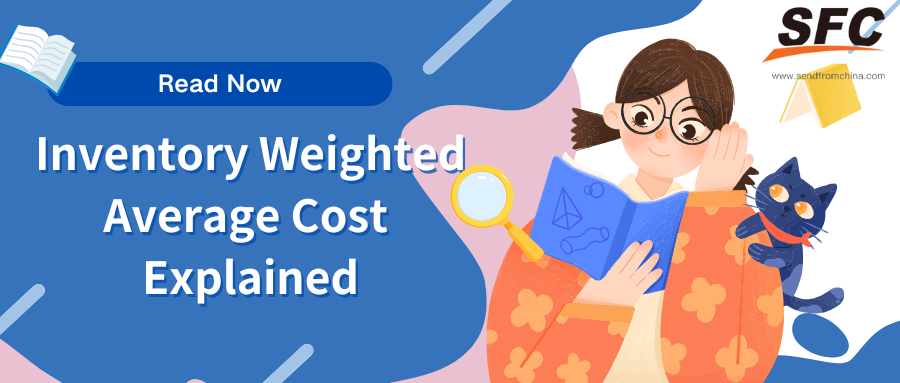Table of Contents
Inventory Weighted Average Cost Explained: Formula, Method & Benefits
Time: May 12,2025 Author: SFC Source: ppcm.com.cn
Managing inventory effectively isn’t just about keeping shelves stocked—it’s about understanding the value of what you’re holding. For businesses that carry similar or interchangeable products, the Inventory Weighted Average Cost (WAC) method offers a simple yet powerful way to calculate inventory value and cost of goods sold (COGS) consistently.
In this guide, we’ll break down what inventory weighted average cost is, how the weighted average cost method works, and the exact formula you need to use it accurately. We’ll also compare WAC with other common inventory valuation methods like FIFO and LIFO, highlight its benefits for accounting and financial planning, and explore how outsourcing inventory management can boost efficiency—especially for ecommerce businesses.
Whether you're an accountant, operations manager, or ecommerce entrepreneur, this article will help you make informed decisions about inventory control and financial reporting.

1. What Is Inventory Weighted Average Cost?
The Inventory Weighted Average Cost method is a fundamental accounting approach used to value inventory and calculate the cost of goods sold. It assigns an average cost to each unit of inventory, smoothing out price fluctuations over time. The method is particularly beneficial for businesses handling large volumes of similar or interchangeable products, such as retailers, manufacturers, and e-commerce companies.
Understanding the Concept
At its core, the WAC method calculates the average cost of all inventory items by dividing the total cost of goods available for sale by the total number of units available. The average cost is then used to determine both the COGS and the value of ending inventory. By doing so, WAC provides a consistent and straightforward means of inventory valuation, especially when individual item costs are indistinguishable or when tracking each item's cost is impractical.
Key Characteristics
Uniform Cost Allocation: All units of inventory are valued at the same average cost, regardless of purchase date or price.Simplified Accounting: Reduces the complexity of tracking individual inventory items and their specific costs.
Price Fluctuation Mitigation: By averaging costs, WAC minimizes the impact of price volatility on financial statements.
2. How to Calculate Inventory Weighted Average Cost?

Calculating the Inventory Weighted Average Cost is a fundamental aspect of inventory management and accounting. The method assigns an average cost to each unit of inventory, smoothing out price fluctuations over time. It's particularly useful for businesses dealing with large volumes of similar or indistinguishable items.
Inventory weighted average cost formula
WAC = Cost of goods available for sale / Total number of units in inventory
3. Weighted Average Cost vs. Other Common Inventory Valuation Methods

Choosing the right inventory valuation method is crucial for accurate financial reporting and effective inventory management. The three primary methods are:
Weighted Average CostFirst-In, First-Out (FIFO)
Last-In, First-Out (LIFO)
Each method has its unique approach, advantages, and considerations. Let's delve into a comparative analysis to understand their differences and applications.
| Method | COGS Impact | Ending Inventory Value | Tax Implications | Compliance |
| WAC | Moderate | Moderate | Neutral | GAAP & IFRS |
| FIFO | Lower during inflation | Higher | Higher taxable income | GAAP & IFRS |
| LIFO | Higher during inflation | Lower | Lower taxable income | GAAP only |
First-In, First-Out (FIFO)
FIFO assumes that the oldest inventory items are sold first. Consequently, the ending inventory consists of the most recently purchased items.
Best Suited For
Businesses where inventory items are perishable or have expiration dates.Companies operating in industries with stable or rising prices.
Advantages
Provides a balance sheet that reflects current market prices.Results in lower COGS during periods of rising prices, leading to higher reported profits.
Complies with both GAAP and IFRS standards.
Considerations
Higher reported profits can lead to increased tax liabilities.May not match the actual physical flow of goods in certain industries.
Last-In, First-Out (LIFO)
LIFO assumes that the most recently acquired inventory items are sold first. Therefore, the ending inventory comprises the oldest items.
Best Suited For
Businesses operating in industries with fluctuating or rising prices.Companies seeking to match recent costs with current revenues.
Advantages
Results in higher COGS during inflationary periods, leading to lower taxable income.Provides better matching of current costs with current revenues.
Considerations
Not permitted under IFRS standards.Can result in outdated inventory valuations on the balance sheet.
May not reflect the actual physical flow of goods.
4. Benefits of Inventory Weighted Average Cost

The Weighted Average Cost method offers several advantages that make it a preferred choice for many businesses when it comes to inventory valuation. By assigning an average cost to inventory items, WAC simplifies accounting processes and provides a consistent approach to inventory management.
Simplified Accounting Process
One of the primary benefits of the WAC method is its simplicity. Unlike other inventory valuation methods that require tracking individual inventory items and their specific costs, WAC calculates a single average cost for all items. The approach reduces the complexity of accounting records and minimizes the potential for errors in cost assignment.
Consistent Financial Reporting
WAC provides a stable and consistent method for valuing inventory, which is particularly beneficial in industries where prices fluctuate frequently. By averaging costs over time, WAC smooths out price variations, leading to more predictable and reliable financial statements. The consistency is valuable for stakeholders who rely on financial reports for decision-making.
Efficient Inventory Management
For businesses dealing with large volumes of similar or interchangeable products, WAC streamlines inventory management. By applying a uniform cost to all units, companies can more easily manage stock levels, assess inventory value, and make informed purchasing decisions without the need to track individual item costs.
Compliance with Accounting Standards
The WAC method is recognized and accepted under both Generally Accepted Accounting Principles (GAAP) and International Financial Reporting Standards (IFRS). This compliance ensures that businesses using WAC can confidently prepare financial statements that meet regulatory requirements and are comparable across different reporting frameworks.
Reduced Impact of Price Volatility
In markets where the cost of goods can vary significantly over time, WAC mitigates the impact of price volatility on inventory valuation. By averaging costs, businesses can avoid significant swings in reported inventory values and cost of goods sold, leading to more stable profit margins and financial performance indicators.
Time and Cost Savings
Implementing the WAC method can lead to time and cost savings in the accounting process. The simplified calculation reduces the administrative burden associated with tracking and assigning specific costs to individual inventory items. This efficiency allows accounting personnel to focus on other critical financial tasks.
Enhanced Decision-Making
With consistent and reliable inventory valuation, businesses can make better-informed decisions regarding pricing strategies, budgeting, and financial planning. The clarity provided by the WAC method supports strategic initiatives and helps in evaluating the financial implications of operational choices.
5. How Outsourcing Inventory Management Helps Grow Your Ecommerce Business

In the dynamic world of ecommerce, efficient inventory management is crucial for sustaining growth and ensuring customer satisfaction. As businesses scale, managing inventory in-house can become increasingly complex and resource-intensive. Outsourcing inventory management to specialized third-party providers offers a strategic solution to these challenges, enabling ecommerce businesses to focus on core competencies while leveraging expert services for inventory control.
Cost Reduction and Resource Optimization
Managing inventory internally requires significant investment in warehouse space, technology, and personnel. Outsourcing eliminates the need for such capital expenditures, converting fixed costs into variable costs that align with business activity levels. The flexibility allows businesses to allocate resources more effectively, investing in areas like marketing, product development, or customer service, which directly contribute to growth.
Streamlined Operations and Enhanced Efficiency
Outsourcing inventory management allows businesses to tap into the expertise of professionals who specialize in logistics and supply chain management. These providers utilize advanced systems and technologies to monitor stock levels, forecast demand, and manage replenishment processes. By delegating these tasks, ecommerce companies can reduce errors, minimize stockouts or overstock situations, and ensure timely order fulfillment, leading to improved operational efficiency.
Scalability to Support Business Growth
As ecommerce businesses expand, their inventory management needs become more complex. Outsourcing partners offer scalable solutions that can adapt to changing demands, whether it's handling seasonal fluctuations, entering new markets, or launching additional product lines. The scalability ensures that inventory management systems can grow in tandem with the business, without the need for significant internal restructuring.
Access to Advanced Technology and Expertise
Third-party inventory management providers invest in cutting-edge technologies, such as real-time inventory tracking, automated replenishment systems, and data analytics tools. By outsourcing, ecommerce businesses gain access to these technologies without the associated development and maintenance costs. Additionally, they benefit from the provider's industry expertise, ensuring best practices are applied to inventory processes.
Improved Customer Satisfaction
Efficient inventory management directly impacts customer experience. By ensuring product availability and timely delivery, outsourcing partners help maintain high service levels. This reliability fosters customer trust and loyalty, which are essential for repeat business and positive word-of-mouth referrals.
Focus on Core Business Activities
By entrusting inventory management to external experts, ecommerce businesses can concentrate on strategic initiatives such as brand development, market expansion, and customer engagement. This focus enables companies to drive innovation and competitive differentiation, essential factors for long-term success in the ecommerce landscape.
6. Conclusion
The Weighted Average Cost method provides a straightforward and consistent approach to inventory valuation, particularly beneficial for businesses dealing with large volumes of similar items. By averaging costs, it simplifies accounting processes and aids in accurate financial reporting. Additionally, outsourcing inventory management can further enhance operational efficiency, allowing businesses to focus on growth and customer satisfaction.
7. FAQs
Q1: Is the Weighted Average Cost method suitable for all types of businesses?
A1: It's most effective for businesses with large volumes of similar inventory items.
Q2: How does WAC handle price fluctuations?
A2: It smooths out price changes by averaging costs over time.
Q3: Can WAC be used under both GAAP and IFRS?
A3: Yes, it's accepted under both accounting standards.
Q4: Does WAC simplify inventory tracking?
A4: Yes, it reduces the need to track individual inventory items.
Q5: What are the main benefits of outsourcing inventory management?
A5: Cost savings, expertise access, scalability, and operational focus.
 Post Views:8
Post Views:8
Copyright statement: The copyright of this article belongs to the original author. Please indicate the source for reprinting.
Previous Post
Next Post
What Is Physical Distribution? A Complete Guide for E-commerce Success
TAGS
Hot Research
Recent News
Get a Custom China Fulfillment Solution with FREE Storage for 60 Days
 Want to know about our services, fees or receive a custom quote?
Want to know about our services, fees or receive a custom quote?
 Please fill out the form on the right and we will get back to you within a business day.
Please fill out the form on the right and we will get back to you within a business day.
 The more information you provide, the better our initial response
will be.
The more information you provide, the better our initial response
will be.





 TAGS:
TAGS: